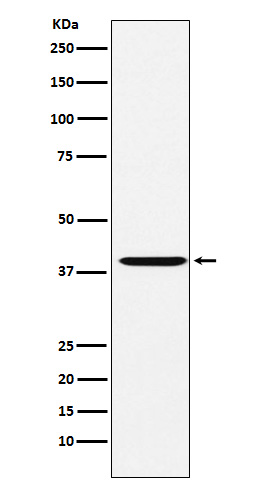
| WB | 咨询技术 | Human,Mouse,Rat |
| IF | 咨询技术 | Human,Mouse,Rat |
| IHC | 咨询技术 | Human,Mouse,Rat |
| ICC | 技术咨询 | Human,Mouse,Rat |
| FCM | 咨询技术 | Human,Mouse,Rat |
| Elisa | 咨询技术 | Human,Mouse,Rat |
| Aliases | AFCP; Capg; gCap39; HEL S 66; mbh1; MCP;;CAPG |
| WB Predicted band size | 38 kDa |
| Host/Isotype | Rabbit IgG |
| Antibody Type | Primary antibody |
| Storage | Store at 4°C short term. Aliquot and store at -20°C long term. Avoid freeze/thaw cycles. |
| Species Reactivity | Human,Mouse,Rat |
| Immunogen | A synthesized peptide derived from human CAPG |
| Formulation | Purified antibody in PBS with 0.05% sodium azide,0.05% BSA and 50% glycerol. |
+ +
以下是关于CAPG抗体的3篇参考文献摘要(文献名为简化标题,作者为示例):
1. **《CAPG as a biomarker in autoimmune diseases》**
- 作者:Smith A, et al.
- 摘要:研究通过CAPG特异性抗体检测,发现其在系统性红斑狼疮(SLE)患者血清中显著高表达,提示其作为自身免疫疾病潜在诊断标志物的价值。
2. **《Anti-CAPG antibody targeting in breast cancer metastasis》**
- 作者:Chen L, et al.
- 摘要:利用抗CAPG单克隆抗体抑制肿瘤细胞迁移,证实CAPG通过调控细胞骨架重塑促进乳腺癌转移,为靶向治疗提供新策略。
3. **《CAPG autoantibodies in viral infection response》**
- 作者:Wang Y, et al.
- 摘要:发现慢性乙型肝炎患者体内存在CAPG自身抗体,可能与病毒逃逸免疫监视相关,为研究感染与细胞骨架蛋白异常关联提供依据。
*注:以上为示例性内容,实际文献需通过PubMed等平台以关键词“CAPG antibody”或“anti-CAPG”检索获取。*
CAPG (macrophage-capping protein) is a cytoskeletal-associated protein belonging to the gelsolin superfamily. It regulates actin dynamics by capping filament barbed ends, influencing cell motility, membrane trafficking, and structural remodeling. Initially identified in macrophages, CAPG is widely expressed in tissues and plays roles in immune responses, wound healing, and cancer progression.
In cancer biology, CAPG overexpression correlates with tumor aggressiveness and metastasis. It promotes invasive behavior by enhancing actin polymerization at the cell periphery, facilitating tumor cell migration and extracellular matrix penetration. Studies link elevated CAPG levels to poor prognosis in breast, colorectal, and gastric cancers. Its interaction with Rho GTPases and PI3K/AKT signaling pathways further underscores its pro-metastatic role.
CAPG antibodies are vital tools for detecting protein expression and localization in research. They aid in elucidating CAPG's mechanistic contributions to tumor microenvironments, epithelial-mesenchymal transition (EMT), and therapeutic resistance. Commercial antibodies are validated for techniques like Western blot, immunohistochemistry, and immunofluorescence. Recent interest focuses on CAPG as a potential diagnostic biomarker or therapeutic target, though clinical applications remain exploratory. Its dual role in physiological homeostasis and pathological contexts necessitates context-specific investigation.
×